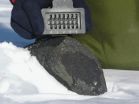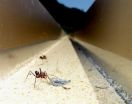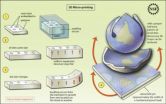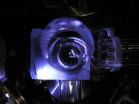(Press-News.org) WASHINGTON -- The U.S. Coast Guard Cutter HEALY (WAGB 20) successfully experimented with NRL's TacSat-4 communications satellite, Jan. 24, by communicating from the Bering Sea off the western coast of Alaska to Coast Guard Island, Alameda, Calif.
Returning from an escort and icebreaking mission to Nome, Alaska, assisting the Russian tanker Renda delivery of emergency fuel to the town, USCGC HEALY — Coast Guard's only polar icebreaker — was approximately 260 nautical miles south of the Arctic Circle at the time of the test.
Deployed into a unique, highly elliptical orbit with an apogee of 12,050 kilometers, TacSat-4 helps augment current geosynchronous satellite communication by including the high latitudes. The experiment was the first in a series of planned steps that aim to demonstrate TacSat-4's utility in the polar and arctic regions.
Also participating in communications with HEALY was the Army Space and Missile Defense Battle Lab (SMDBL) located in Colorado Springs, Col. The SMDBL team was conducting portions of the ongoing TacSat-4 Joint Military Utility Assessment (JMUA).
Managed by the U.S. Naval Research Laboratory, Naval Center for Space Technology, TacSat-4 is an experimental spacecraft that will test advances in several technologies and SATCOM techniques. It will augment the existing fleet with an additional space asset to provide communications to otherwise under-served users and areas that either do not have high enough priority or do not have satellite visibility.
The Office of Naval Research (ONR) is funding the first year of TacSat-4 operations. The Operationally Responsive Space (ORS) Office is leading and funding the JMUA of TacSat-4.
INFORMATION:
TacSat-4 enables polar region SatCom experiment
2012-03-12
ELSE PRESS RELEASES FROM THIS DATE:
Mapping the Moho with GOCE
2012-03-12
The first global high-resolution map of the boundary between Earth's crust and mantle – the Moho – has been produced based on data from ESA's GOCE gravity satellite. Understanding the Moho will offer new clues into the dynamics of Earth's interior.
Earth's crust is the outermost solid shell of our planet. Even though it makes up less than 1% of the volume of the planet, the crust is exceptionally important not just because we live on it, but because is the place where all our geological resources like natural gas, oil and minerals come from.
The crust and upper mantle ...
Meteorites reveal another way to make life's components
2012-03-12
Creating some of life's building blocks in space may be a bit like making a sandwich – you can make them cold or hot, according to new NASA research. This evidence that there is more than one way to make crucial components of life increases the likelihood that life emerged elsewhere in the Universe, according to the research team, and gives support to the theory that a "kit" of ready-made parts created in space and delivered to Earth by impacts from meteorites and comets assisted the origin of life.
In the study, scientists with the Astrobiology Analytical Laboratory ...
Infection control certification associated with lower MRSA infection rates
2012-03-12
Washington, DC, March 9, 2012 -- Hospitals whose infection prevention and control programs are led by a director who is board certified in infection prevention and control have significantly lower rates of methicillin-resistant Staphylococcus aureus (MRSA) bloodstream infections (BSI) than those that are not led by a certified professional, according to a new study published in the March issue of the American Journal of Infection Control, the official publication of APIC - the Association for Professionals in Infection Control and Epidemiology.
A team of researchers ...
Orientation of desert ants: Every cue counts
2012-03-12
Desert ants have adapted to a life in a barren environment which only provides very few landmarks for orientation. Apart from visual cues and odors the ants use the polarized sunlight as a compass and count their steps in order to return safely to their home after searching for food. In experiments with ants of the genus Cataglyphis in their natural habitats in Tunisia and Turkey, behavioral scientists of the Max Planck Institute for Chemical Ecology in Jena, Germany, have now discovered that ants can also use magnetic and vibrational landmarks in order to find their way ...
Researchers 'print' polymers that bend into 3-D shapes
2012-03-12
Christian Santangelo, Ryan Hayward and colleagues at the University of Massachusetts Amherst recently employed photographic techniques and polymer science to develop a new technique for printing two-dimensional sheets of polymers that can fold into three-dimensional shapes when water is added. The technique may lead to wide ranging practical applications from medicine to robotics
The journal Science publishes the research in its March 9 issue.
Researchers used a photomask and ultraviolet (UV) light to "print" a pattern onto a sheet of polymers, a technique called photolithography. ...
Genetic marker for painful food allergy points to improved diagnosis, treatment
2012-03-12
Researchers have identified a genetic signature for a severe, often painful food allergy – eosinophilic esophagitis – that could lead to improved diagnosis and treatment for children unable to eat a wide variety of foods.
The scientists, from Cincinnati Children's Hospital Medical Center, report in the Journal of Allergy and Clinical Immunology that they have pinpointed a dysregulated microRNA signature for eosinophilic esophagitis (EoE), a disease that also may cause weight loss, vomiting, heartburn and swallowing difficulties.
Interestingly, the dysregulated microRNA ...
New 'pendulum' for the ytterbium clock
2012-03-12
The faster a clock ticks, the more precise it can be. Due to the fact that lightwaves vibrate faster than microwaves, optical clocks can be more precise than the caesium atomic clocks which presently determine time. The Physikalisch-Technische Bundesanstalt (PTB) is even working on several of such optical clocks simultaneously. The model with one single ytterbium ion caught in an ion trap is now experiencing another increase in accuracy. At PTB, scientists have succeeded in exciting a quantum-mechanically strongly "forbidden" transition of this ion and – in particular – ...
Iridescent, feathered dinosaur: New evidence that feathers evolved to attract mates
2012-03-12
The detailed feather pattern and color of Microraptor--a pigeon-sized, four-winged dinosaur that lived about 120 million years ago--had a glossy iridescent sheen.
Its tail was narrow and adorned with a pair of streamer feathers, suggesting the importance of display in the early evolution of feathers, say scientists reporting the findings in this week's issue of the journal Science.
By comparing the patterns of pigment-containing organelles from a Microraptor fossil to those in modern birds, the scientists determined that the dinosaur's plumage was iridescent with a ...
NOHO Dental Group Now Offers Several Special Promotions for New and Existing Patients
2012-03-12
NOHO Dental Group and Dr. Afar, North Hollywood dentist, are offering a variety of specials for new and existing patients. For a short time, patients can receive discounts on a wide number of dental procedures, allowing both new patients and those who have been with the NOHO Dental Group for years to save money and try new dental services.
These specials include a wide variety of services, such as a $49 dental exam with x-rays for new patients. For patients who need preventative care like dental cleanings, this special allows new patients to try out the services of Dr. ...
NIH study links childhood cancer to developmental delays in milestones
2012-03-12
Infants and toddlers who have been treated for cancer tend to reach certain developmental milestones later than do their healthy peers, say researchers at the National Institutes of Health and in Italy.
The findings show that delays may occur early in the course of treatment and suggest that young children with cancer might benefit from such early interventions as physical or language therapy.
Compared to children who had not had cancer, children treated for cancer before age 4 progressed more slowly in vocabulary, cognitive functions such as attention and memory, and ...






